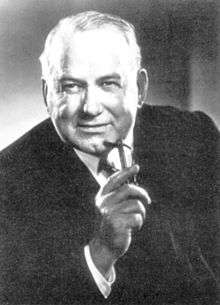Ernest Hives, 1st Baron Hives
| The Lord Hives | |
|---|---|
 | |
| Born |
21 April 1886 Reading, Berkshire, England |
| Died |
24 April 1965 (aged 79) London, England |
| Nationality | United Kingdom |
| Occupation | Engineer |
| Known for | Rolls-Royce Merlin |
| Awards |
Companion of Honour (CH) Member of the Order of the British Empire (MBE) |
Ernest Walter Hives, 1st Baron Hives CH MBE (21 April 1886 – 24 April 1965), was the one-time head of the Rolls-Royce Aero Engine division and chairman of Rolls-Royce Ltd.[1]
Hives was born in Reading, Berkshire. During the Second World War he was closely involved with the design of the Merlin engine as well as numerous later Rolls-Royce jet engines. He began his working life in a local garage. However, in 1903 he got a job working at C.S. Rolls' car company, after fixing Rolls' car.
Achievements
After becoming a chief test driver in 1908, he led the RR team in the Austrian Alpine Trial in 1913. During the First World War the company designed its first aero-engine, the Eagle, and Hives developed it successfully, by 1916 he was Head of the Experimental Department.[2] In 1919 the Eagle powered the twin-engined Vickers Vimy bomber on the first direct flight across the Atlantic. Other notable engines were later developed under Hives’ lead. Of these the Buzzard was the most important, leading to the ‘R’ series, which powered the Supermarine S.6 seaplanes that won the Schneider Trophy in 1929 and 1931 for Rolls-Royce, and most importantly the famous Merlin engine.
In 1936 he became the general works manager of the factory and a year later was elected to the board. He lived at 37, St. Chads Rd., Derby until around 1937, then at 'Hazeldene', Duffield.[3] In 1937, thinking war would soon be inevitable, he prepared the firm for a massive production increase in Merlin engines by splitting facilities between engineering and production. As the Merlin powered Hurricanes and Spitfires, this was a decision of vital strategic significance when war did come. It was thanks to Hives that a total of a hundred and sixty thousand Merlins were produced by 1945. In 1941 Hives quickly decided ‘to go all out for the gas turbine’, ensuring the company’s leading role in developing jet engines for civil and military aviation.[4]
Vice Chief of Air Staff Sir Wilfrid Freeman, one of the masterminds behind the dramatic advances in British aircraft production before and during World War 2, paid tribute to Hives's dedication in a letter to his wife:
That man Hives is the best man I have ever come across for many a year. God knows where the RAF would have been without him. He cares for nothing except the defeat of Germany and he does all his work to that end, living a life of unending labour.[5]
Hives became managing director in 1946 and chairman of Rolls-Royce from 1950 till 1957. He was appointed to the Order of the Companions of Honour in the 1943 Birthday Honours[6] and on 7 July 1950 he was raised to the peerage as Baron Hives, of Duffield in the County of Derby.[7]
He played a critical role in the UK Nuclear Submarine programme. When the highly irascible but utterly pivotal Admiral Rickover visited the UK in 1957 to inspect the British nuclear design team at Rolls Royce, Rickover was “at his obnoxious worst”. After one particularly difficult morning he was introduced to Lord Hives.
‘A lord eh? Chairman eh? And what are you then, a banker or a lawyer or what?’ said Rickover. ‘What me? No, no, no, no, no! Me, I’m just a mechanic, just a bloody plumber.’ said Hives, with a big board smile on his face. Rickover was thrown, he had not expected that kind of answer. When Hives explained that he had known Henry Royce himself, had worked for him, and had absorbed from him his passion for engineering excellence Rickover’s mood an attitude started to improve. Hives spent much of the lunch telling a captivated Rickover about Royce’s obsession with achieving perfection. He then took Rickover on a personal tour of the works, not in a Rolls-Royce or Bentley but in a very modest Hillman.…when Hives returned after showing Rickover around… the Admiral was a changed man, subdued, pleasant, cooperative, uncritical, and no further put-downs or denigrations of British engineering escaped his lips... That hour of dialogue… changed everything in the British nuclear submarine programme.[8]
His son, Pilot Officer Edward Ernest Hives, was killed in action flying with RAF Coastal Command in October 1940.[9] He retired in 1957 and died in April 1965, aged 79. He was succeeded in the barony by his son John.
His younger daughter, Philippa Hives, married Judge Alexander Morrison in 1978.
References
Notes
- ↑ Lumsden 2003, p. 9.
- ↑ Pugh 2000, p. 109.
- ↑ Watson W.R. 1991, p. 140.
- ↑ Pugh 2000, p. 287.
- ↑ Furse 2000, p. 337.
- ↑ "No. 36033". The London Gazette (Supplement). 28 May 1943. p. 2438.
- ↑ "No. 38968". The London Gazette. 14 July 1950. p. 3622.
- ↑ Hennessy and Jinks 2015, p. 167.
- ↑ Watson W.R. 1991, p. 140.
Bibliography
- Lumsden, Alec. British Piston Engines and their Aircraft. Marlborough, Wiltshire: Airlife Publishing, 2003. ISBN 1-85310-294-6.
- Pugh, Peter. The Magic of a Name - The Rolls-Royce Story - The First 40 Years. Cambridge, England. Icon Books Ltd, 2000. ISBN 1-84046-151-9
- Furse, Anthony. Wilfrid Freeman: the genius behind Allied survival and air supremacy 1939 to 1945. Staplehurst. Spellmount, 2000. ISBN 1-86227-079-1
- Hennessy, Peter and Jinks, James. The Silent Deep Allen Lane 2015 ISBN 978-1-846-14580-3
- Watson, W.R. The Derbyshire village of Duffield, past and present. Chevin Books, 1991. ISBN 0-9511563-1-4
| Peerage of the United Kingdom | ||
|---|---|---|
| Preceded by New Creation |
Baron Hives | Succeeded by John Warwick Hives |